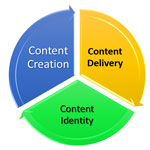We all know that a reliable revenue model is one of the major pillars of a viable content strategy.
Here I’ve listed some of the most popular revenue models used by content-based businesses.
While I admit that this is not a comprehensive list of all possible revenue models, it can be a good starting point for anyone interested in generating revenue with content creation and delivery.
Direct vs. Indirect Revenue Models
Generally speaking, there are two fundamentally different types of content revenue models:
While direct revenue models consider the audience (or content consumer) as their source of revenue, indirect revenue models differentiate between users and customers.
It means that the audience consumes the content freely and the content business generates revenue through third parties.
Some Examples of Direct Revenue Models
Here you can find a list of the most popular direct revenue models used by content-based businesses:
- Content as the facilitator of the selling process
- Selling Content as a product
- Subscription-based revenue models
- Collecting donations
Content as Facilitator of Selling Products and Services
This is one of the classic approaches to revenue generation in the online world and most of the first e-commerce websites were grounded on such a basis.
For example, you have a CRM solution, and create a large amount of content around this topic.
There are various roads to revenue through this approach to the content creation:
- Attracting visitors who are interested in CRM products (inbound marketing) and introducing/selling them your solution.
- Educating people and aligning them with your approach to the CRM (It will be easier to convince them / their companies to buy your product)
- Building brand awareness for your company/product and using it as a competitive advantage in the market
Selling Content as a Product
The content itself can be sold as a product. Selling audiobooks, pdf files, research papers, and market reports, are still popular in various topics and can be considered as a source of revenue.
However, you have to find your own ways of dealing with the content piracy.
Subscription-based Revenue Model
Subscription-based revenue model, sometimes call time-based access models, are very popular in the content industry.
Many news outlets offer different packages for monthly, quarterly and yearly access to their articles.
But such a model is not limited to journals and news publishing companies. Many streaming services (such as NetFlix and Spotify) use a similar model for selling their content to the audience.
Further Reading: Subscription Revenue Model (Definition & Examples)
Collecting Donations
Yes. Collecting donations can be a revenue model for content creating organizations. In this model, you provide content to the audience and ask them to donate if the content is helpful and they are happy with it.
Brainpickings and Wikipedia are just two examples of the content creation services based on user donations (Brainpickings as content pipeline and Wikipedia as a content creation platform).
Collecting donations can be considered as a crowdfunding business model in which funders are not looking for their principal money and its interest.
No matter you call it donation game or crowdfunding, sure the success of this type of revenue model depends heavily on the audience culture and type of the content you provide.
Many of the donation-based revenue models, use it just as a complementary revenue stream. It means that they have a primary revenue source (such as creating and delivering sponsored content) and use donations to complement or cover the other revenue streams.
Some Examples of Indirect Revenue Models
Here I have listed some of the popular indirect revenue models used by content creators:
Selling Advertising Space
Selling advertising space is still the most popular indirect revenue model in the online content-creation world.
Many social media companies, news websites, personal blogs, and professional forums, rely on selling advertising space to the other businesses.
Some of these businesses (usually the ones with a large audience base) sell ad-space directly to the others, while smaller ones, use the third-party platforms such as Google’s Adsense service.
The Ad Space Selling (ASS) Revenue Model is as old as the modern content industry itself. This practice got popular even before the digital age by newspapers, radio stations, and other mass media.
Collecting User Information
Latest advances in big data and data mining practices have resulted in various opportunities for turning the user information into money. Here are just some of the marketable user information which many companies and organizations are willing to pay for them:
- Market Demographics
- User Values and Preferences
- Search Terms
- Product Comparison Cases
- Contact Information
- Market Gaps
- User Needs
As such reports need a large user base, it’s more often used by content platforms (e.g. social media) than content pipelines.
Extracting and selling this kind of information has always been a source of debate, with many ethical activists criticising them as unethical. However, the companies usually refer the critics to the not-read-but-easily-signed terms and conditions while users register for the service.
Sponsorship
Sponsorship contracts are used by businesses as a part of brand awareness or brand identity management efforts.
In this model, a business covers the whole business costs (sometimes with a markup) and asks the content creator to guarantee a certain level of some performance metrics.
Alexa Rank and total monthly visitors are among the most popular metrics used
These kinds of sponsorship contracts are not limited to the companies. Nowadays, you can find many individuals who enter sponsorship deals with content creating businesses, to improve their competitive position in the professional services market.






